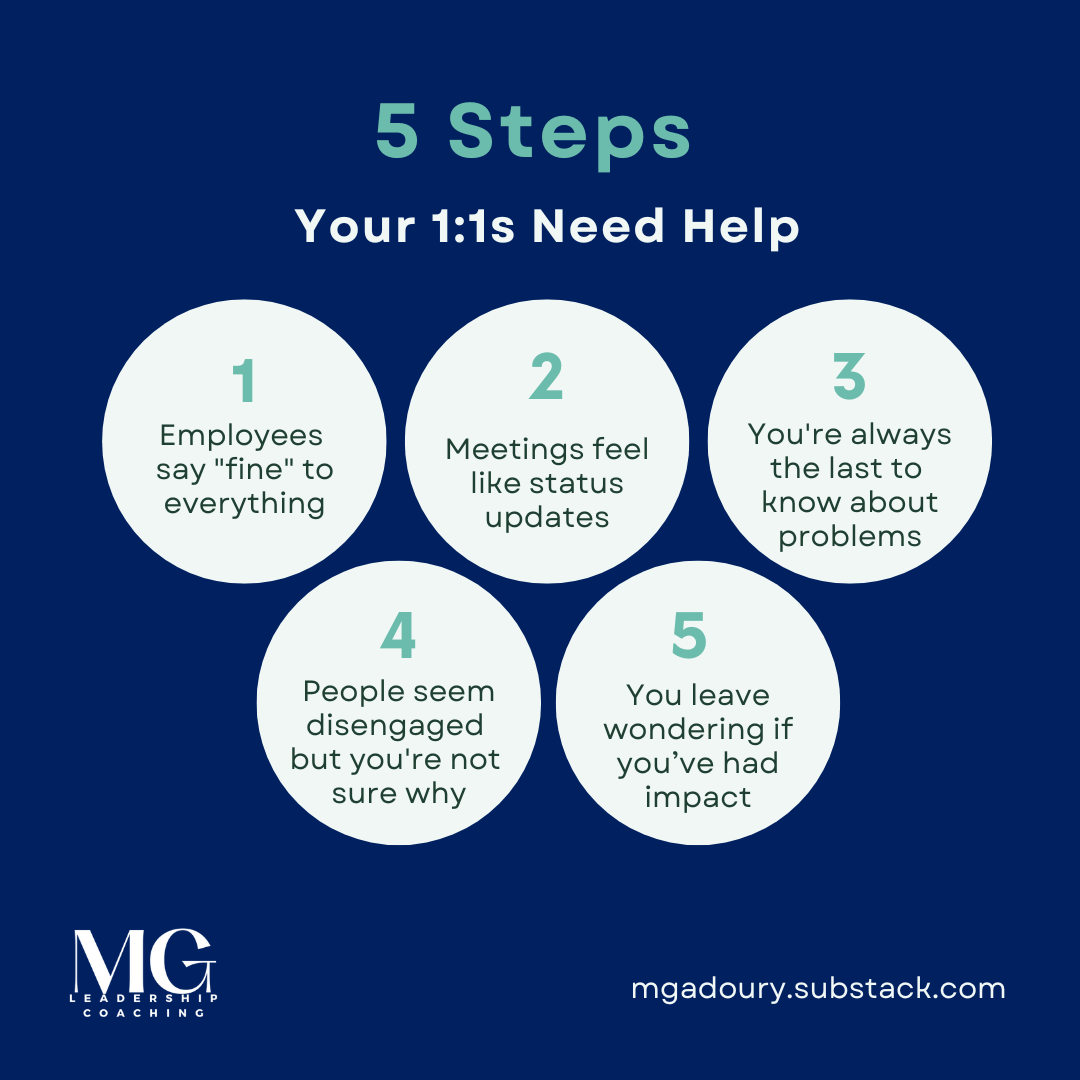Welcome to The Evolving Leader's Guide. Each week, I share one mindset, framework, or toolkit designed to help you become a more effective leader—so you can lead with confidence, inspire your team, and build a career you're proud of.
This week's tool: ChatGPT, Claude, or any AI chat tool (seriously, the basic ones work fine for this)
Most 1:1s feel rushed, awkward, or like glorified status updates. Managers either wing it or get stuck in surface-level conversations—and employees can tell.
Employees walk away thinking "well, that was 30 minutes I'll never get back." Managers wonder why they bothered scheduling it.
The typical approach treats 1:1s like project standups with feelings sprinkled on top. "How are things going?" "Fine." Review tasks. Meeting over.
Meanwhile, top performers get bored. Struggling team members don't get the support they need. Early warning signs get missed that could prevent bigger problems later.
A good 1:1 builds trust, uncovers risks early, and helps people grow. A mediocre one fills calendar time without creating value.
When 1:1s stay surface-level for months, good people start looking elsewhere. Problems that could've been caught early become team fires. And managers wonder why their best performers seem disengaged or why they're always the last to know about issues.
AI tools, like Claude.ai or Chat GPT, can help managers prep smarter, ask better questions, and reflect on what matters—turning missed coaching moments into meaningful conversations.
AI doesn’t replace your human connection—it makes it easier to have conversations that matter. Think of it as a prep assistant, pattern spotter, and coaching booster—all in one
Here are 5 AI prompts you can use to transform standard check-ins into growth conversations:
Before you start
Give your AI this context to make the prompts more useful:
"I'm a [your role] at a [company type/size]. I manage a team of [number] [roles]. I've been managing for [time period]."
Example: "I'm a senior engineering manager at a mid-size tech company. I manage a team of 8 engineers. I've been managing for 2 years."
1. Get past surface-level responses
Skill level: Beginner
The problem with "how are things going?" is that it gets generic answers. Most managers default to safe, broad questions that feel like small talk.
Instead, ask questions that tap into what actually drives people at work. But what motivates your detail-oriented analyst is different from what energizes your big-picture strategist.
The prompt: "Create 5 open-ended questions for my 1:1 my direct report who is currently working on [main project/responsibility]. Focus on understanding their motivation and energy right now."
Why this works: Specific questions about motivation, energy, and challenges get to the real conversation. When they're tailored to someone's actual situation, they feel like genuine interest instead of manager small talk.
2. Turn status updates into development time
Skill level: Beginner
Most 1:1 agendas look like task lists. They're structured around what happened, not what someone learned or how they grew.
This is where you can actually help someone get better at their job instead of just tracking what they did.
The prompt: "Rewrite this agenda to focus on development, not just updates: [paste your current agenda]"
Why this works: Development conversations build careers. Status updates just fill time. Teams can slack project updates—they need managers for growth.
3. Coach instead of solve
Skill level: Intermediate
When someone brings a problem, the instinct is to fix it. This kills their growth. The more you solve for them, the more they'll need you to solve for them.
Teaching someone to think through problems is harder than giving answers, but it's what builds stronger team members.
The prompt: "Give me 3 powerful coaching-style questions based on this update: [paste their situation]"
Why this works: Solving problems creates dependency. Coaching questions help people solve problems themselves—and get better at it.
4. Spot engagement patterns early
Skill level: Intermediate
Most managers wait until someone's already checked out to have the "what's wrong?" conversation. By then, you're in damage control mode.
The key is recognizing patterns before they become problems. But each person shows disengagement differently—what looks like burnout in one employee might look like boredom in another.
The prompt: "What are 5 specific signs I should watch for that might indicate my direct report is becoming disengaged? They're typically [describe their normal energy level and communication style in 1-2 sentences]."
Why this works: Generic warning signs miss the nuances of individual personalities. This gives you personalized red flags based on how this specific person usually shows up at work.
5. Make problems into growth opportunities
Skill level: Advanced
When a team member screws up, it needs to be addressed. But crushing their confidence isn't the goal. The challenge is framing mistakes as learning moments without downplaying their impact.
This approach works for everything from missed deadlines to communication breakdowns.
The prompt: "How can I turn this issue into a growth opportunity during our 1:1: [describe the situation]"
Why this works: Problems are learning opportunities. Effective managers use mistakes as skill-building moments instead of punishment sessions.
Coaching Challenge
Pick one of these prompts and use it in your next 1:1.
Don't try to overhaul everything at once. Just pick the one that addresses the biggest pain point right now.
After the meeting, ask: "Did I learn something new about this person today?" If yes, you're improving.
1:1s can be the highlight of a team's week instead of something they endure. AI just helps get there faster.






